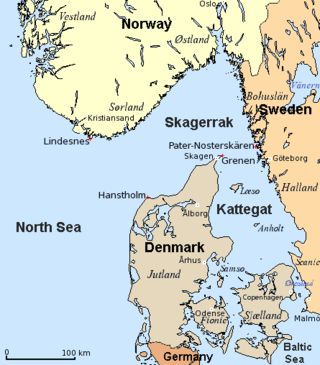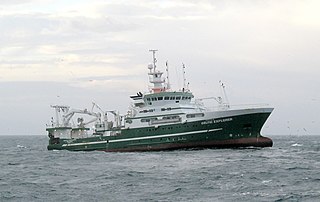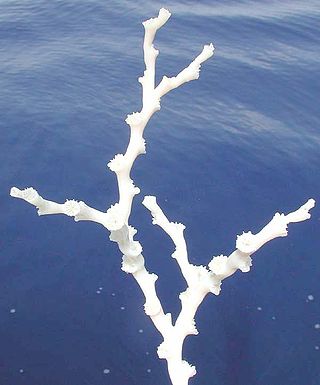
The Skagerrak is a strait running between the Jutland peninsula of Denmark, the southeast coast of Norway and the west coast of Sweden, connecting the North Sea and the Kattegat sea.

A reef is a ridge or shoal of rock, coral or similar relatively stable material, lying beneath the surface of a natural body of water. Many reefs result from natural, abiotic (non-living) processes such as deposition of sand or wave erosion planing down rock outcrops. However, reefs such as the coral reefs of tropical waters are formed by biotic (living) processes, dominated by corals and coralline algae. Artificial reefs such as shipwrecks and other man-made underwater structures may occur intentionally or as the result of an accident, and are sometimes designed to increase the physical complexity of featureless sand bottoms to attract a more diverse range of organisms. Reefs are often quite near to the surface, but not all definitions require this.

Trawling is a method of fishing that involves pulling a fishing net through the water behind one or more boats. The net used for trawling is called a trawl. This principle requires netting bags which are towed through water to catch different species of fishes or sometimes targeted species. Trawls are often called towed gear or dragged gear.

Anthozoa is a class of marine invertebrates which includes the sea anemones, stony corals and soft corals. Adult anthozoans are almost all attached to the seabed, while their larvae can disperse as part of the plankton. The basic unit of the adult is the polyp; this consists of a cylindrical column topped by a disc with a central mouth surrounded by tentacles. Sea anemones are mostly solitary, but the majority of corals are colonial, being formed by the budding of new polyps from an original, founding individual. Colonies are strengthened by calcium carbonate and other materials and take various massive, plate-like, bushy or leafy forms.

Bottom trawling is trawling along the seafloor. It is also referred to as "dragging". The scientific community divides bottom trawling into benthic trawling and demersal trawling. Benthic trawling is towing a net at the very bottom of the ocean and demersal trawling is towing a net just above the benthic zone. Bottom trawling can be contrasted with midwater trawling, where a net is towed higher in the water column. Midwater trawling catches pelagic fish such as anchovies and mackerel, whereas bottom trawling targets both bottom-living fish (groundfish) and semi-pelagic species such as cod, squid, shrimp, and rockfish.

Lophelia pertusa, the only species in the genus Lophelia, is a cold-water coral that grows in the deep waters throughout the North Atlantic ocean, as well as parts of the Caribbean Sea and Alboran Sea. Although L. pertusa reefs are home to a diverse community, the species is extremely slow growing and may be harmed by destructive fishing practices, or oil exploration and extraction.

The Miami Terrace Reef is a coral reef off the coast of Florida stretching from South Miami to Boca Raton, in the Atlantic Ocean. It lies in depths of 650 to 2,000 feet on top of a geological formation known as the Miami Terrace, a 40-mile (65 km) long shelf about 15 miles (24 km) off shore. Much of the platform remains unexplored, and new portions of the reef are still being discovered. University of Miami researchers discovered new reef sites there in December 2005.

The Bear Seamount is a guyot or flat-topped underwater volcano in the Atlantic Ocean. It is the oldest of the New England Seamounts, which was active more than 100 million years ago. It was formed when the North American Plate moved over the New England hotspot. It is located inside the Northeast Canyons and Seamounts Marine National Monument, which was proclaimed by President of the United States Barack Obama to protect the seamount's biodiversity.

Fishing techniques are methods for catching fish. The term may also be applied to methods for catching other aquatic animals such as molluscs and edible marine invertebrates.

The Anton Dohrn Seamount is a guyot in the Rockall Trough in the northeast Atlantic. It is 1.8 kilometres (1.1 mi) high and is topped with pinnacles, one of which reaches a depth of 530 metres (1,740 ft). Away from the flat top upon which the pinnacles rest, the slopes fall off steeply into the Rockall Trough and a moat in the sediment that surrounds the seamount.

Sponge reefs are reefs formed by Hexactinellid sponges, which have a skeleton made of silica, and are often referred to as glass sponges. Such reefs are now very rare, and found only in waters off the coast of British Columbia, Washington and southern Alaska. Recently sponge reefs were identified within the strait of Georgia and Howe sound close to Vancouver. Although common in the late Jurassic period, reef-building sponges were believed to have gone extinct during or shortly after the Cretaceous period, until the existing reefs were discovered Queen Charlotte sound in 1987–1988 – hence these sometimes being dubbed living fossils.

The habitat of deep-water corals, also known as cold-water corals, extends to deeper, darker parts of the oceans than tropical corals, ranging from near the surface to the abyss, beyond 2,000 metres (6,600 ft) where water temperatures may be as cold as 4 °C (39 °F). Deep-water corals belong to the Phylum Cnidaria and are most often stony corals, but also include black and thorny corals and soft corals including the Gorgonians. Like tropical corals, they provide habitat to other species, but deep-water corals do not require zooxanthellae to survive.
This is a glossary of terms used in fisheries, fisheries management and fisheries science.
Destructive fishing practices are practices that easily result in irreversible damage to aquatic habitats and ecosystems. Many fishing techniques can be destructive if used inappropriately, but some practices are particularly likely to result in irreversible damage. These practices are mostly, though not always, illegal. Where they are illegal, they are often inadequately enforced.

Hotspot Ecosystem Research and Man's Impact On European Seas (HERMIONE) is an international multidisciplinary project, started in April 2009, that studies deep-sea ecosystems. HERMIONE scientists study the distribution of hotspot ecosystems, how they function and how they interconnect, partially in the context of how these ecosystems are being affected by climate change and impacted by humans through overfishing, resource extraction, seabed installations and pollution. Major aims of the project are to understand how humans are affecting the deep-sea environment and to provide policy makers with accurate scientific information, enabling effective management strategies to protect deep sea ecosystems. The HERMIONE project is funded by the European Commission's Seventh Framework Programme, and is the successor to the HERMES project, which concluded in March 2009.

Marine habitats are habitats that support marine life. Marine life depends in some way on the saltwater that is in the sea. A habitat is an ecological or environmental area inhabited by one or more living species. The marine environment supports many kinds of these habitats. Marine habitats can be divided into coastal and open ocean habitats. Coastal habitats are found in the area that extends from as far as the tide comes in on the shoreline out to the edge of the continental shelf. Most marine life is found in coastal habitats, even though the shelf area occupies only seven percent of the total ocean area. Open ocean habitats are found in the deep ocean beyond the edge of the continental shelf.
The Rost Reef is a deep-water coral reef off the coast of the Lofoten islands in Nordland county, Norway. The reef was discovered in 2002, about 100 kilometres (62 mi) west of the island of Røstlandet. It extends over a length of about 43 kilometers (27 mi), and has a width of up to 6.9 kilometers (4.3 mi). The reef is generated by the coral Lophelia pertusa, and is the world's largest known Lophelia reef. It is also the world's largest known deep-water coral reef. The authorities have introduced regulations to protect the reef against trawling. The temperature of the waters near the bottom of the Rost coral reef is 2 °C. WWF recognises the Røst Reef as a global natural heritage that merits protection through Marine Protected Area (MPA) status.

Paragorgia arborea is a species of coral in the family Paragorgiidae, commonly known as the bubblegum coral because of its bulbous branch tips. It mainly grows in depths between 200 and 1,300 metres at temperatures between 3 and 8 °C. It is found widespread in the Northern Atlantic Ocean and Northern Pacific Ocean on seamounts and knolls, and was first described by the Swedish naturalist Carl Linnaeus in 1758. P. arborea is a foundation species, providing a habitat for other species in deep sea coral ecosystems.
The Childs Bank Marine Protected Area is an offshore conservation region in the exclusive economic zone of South Africa
Rubicundus lopheliae, the lophelia hagfish, is a species of jawless fish in the family Myxinidae.














